What is Retrospective in Agile Development? Examples of methods and ways of doing things
In agile development , retrospective is “looking back”.
Retrospectives are important as a Scrum team iterates through sprints.
Of course, it is important in terms of product quality, but retrospectives are also very important for the growth of the Scrum team.
In order for the Scrum team to grow, I want you to keep in mind that you should always speak positively in the retrospective!
In this article, I will introduce typical retrospective methods, but it is common to say that retrospective is a positive place for all methods.
In this article, we’ll discuss why retrospectives are important and some best practices.
 Joe Justice
Joe JusticeAt the same time as learning the retrospective method and method, I would like you to learn that the Scrum team can grow in the retrospective.
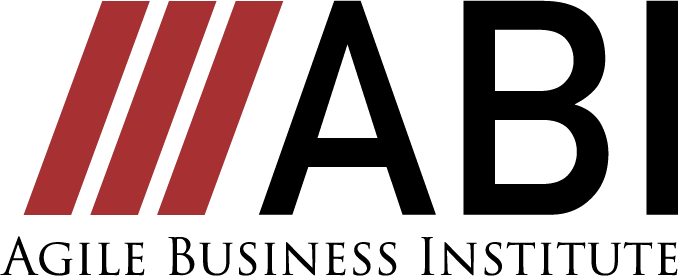




Find out in this article
- What is retrospective? Can understand the outline and purpose
- Know how to do a retrospective
- Retrospective method
- Learn examples of refinement failures and points to note
- Joe’s Advice on Refinements
What is a Sprint Retrospective?
Retrospective means “looking back” in Japanese.
In the sprint, look back at “what went well” and “what went wrong”.
The purpose is to incorporate the conversations and learnings that arise from reflection into the next step as “improvements.” This allows us to continuously improve not only the way we work, but also the quality.
Why is a Sprint Retrospective necessary?
In a nutshell, Sprint Retrospectives are necessary to enable teams to continuously improve .
Most of the time, I just do the task in front of me and just move on to the next task. Retrospectives help teams improve how they work by looking back at their work and processes.
What are the benefits of the Sprint Retrospective?
In retrospective, we look back on “process”, “technology” and “team”. The point I want to note is that it is not a place to check or look back on the product.
Continuing to improve “process”, “technology” and “team” enhances team power and brings many benefits.
Promote communication and enhance team strength
Retrospectives allow everyone to contribute ideas, vent frustrations, and participate in decision making. This increases transparency and openness and creates an environment of trust within the team.
Improve team productivity
Reviewing and improving processes, technology, and team psychological safety can lead to increased productivity.
How to do a Sprint Retrospective
There is no single correct technique for retrospectives.
Many techniques exist for retrospectives.
There are really a lot of things, from commonly used ones to unique ones.
The important thing is to make it an opportunity for all team members to celebrate their successes and reflect on their failures.
Whatever method you use, you should be able to achieve this.



Below are some recommended methods.
The Sprint Retrospective methodology
We will explain how to pick up from commonly used ones to slightly unique ones.



You can use any of them, and it is also recommended to change the method from time to time.
- KPTA
- Fun Done Learn
- 4L
- What Went Wel
- Start Stop Continue
- Mad sad Glad
- speed boat
- starfish
- three little pigs
- speed car
KPTA
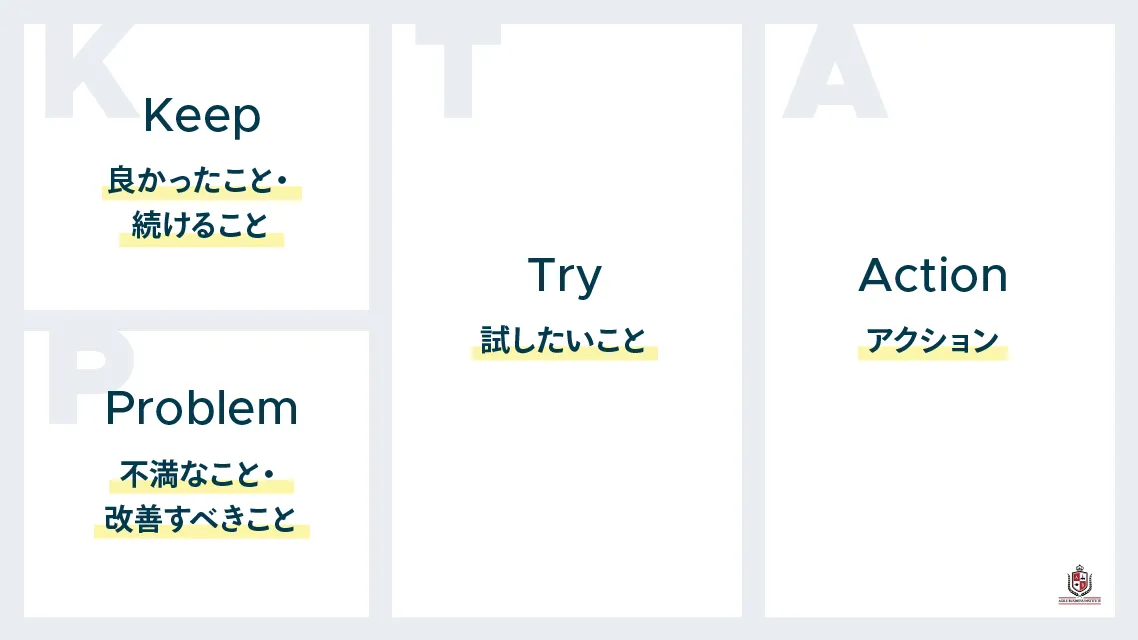

The KPTA framework is based on the four perspectives of “Keep”, “Problem”, “Try”, and “Action”. It is a retrospective method that thinks in a framework.
Each team member writes “Keep” and “Problem” on a chart while looking back on the sprint. Share “Keep” and “Problem” within the team.
Write and display improvement proposals for “Keep” and “Problme” in “Try”. Even if it is not related to “Keep” and “Problem”, I also write “Try” for new challenges.
Share “Tries” with your team.
“Try” is an improvement, and you don’t have to do all of the things listed. The selected “Try” is put into action and materialized. Write this in “Action” and display it in the table.
Fun Done Learn
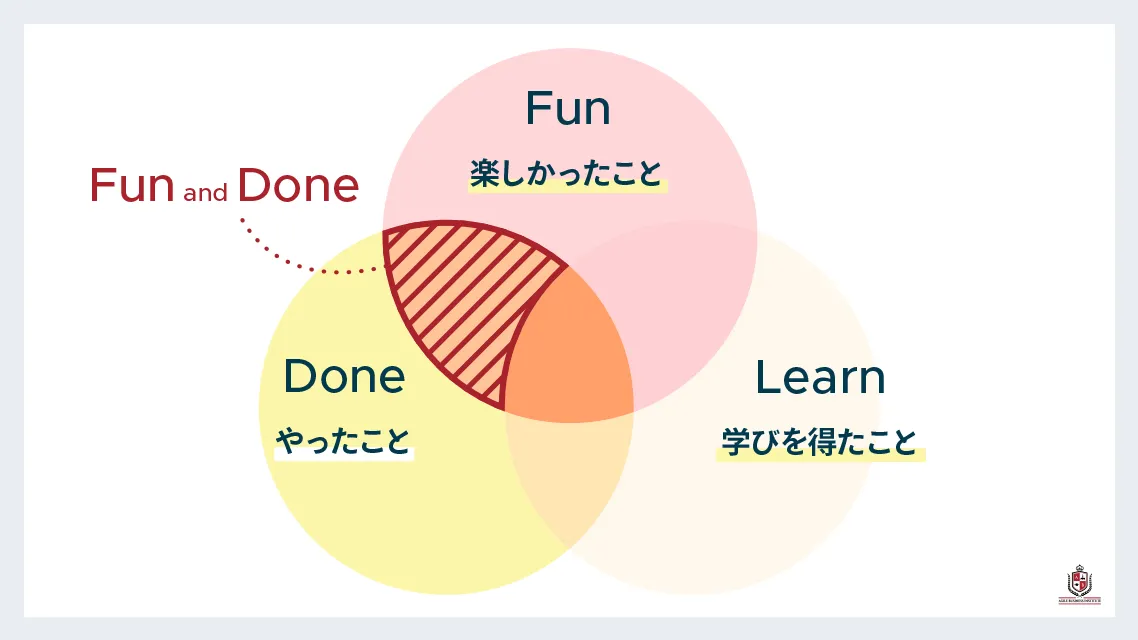

Fun Done Learn is a retrospective method that uses a framework to think from the three perspectives of “Fun”, “Done”, and “Learn”. It is the simplest framework among retrospective methods.
Each team member writes “Fun”, “Done”, and “Learn” and displays them on the chart while reviewing the sprint. It may apply to only one, or it may apply to two, or three.
Share with your team and figure out which areas you want to improve in the next sprint.
4L
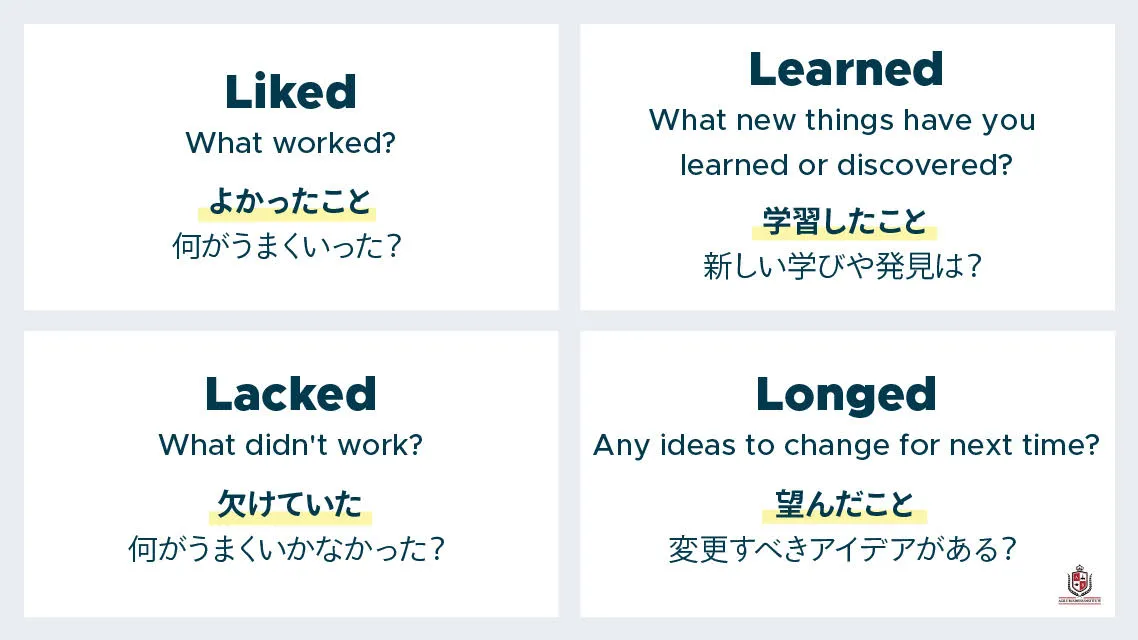

4L is a retrospective that uses a framework to think from the four perspectives of ” liked”, “learned”, “lacked”, and “longed”. method.
Each team member writes “Like”, “Learned”, “Lacked”, and “Longed” on the chart as they review the sprint. Share within the team.
Most of the time, we vote on which items we want to improve in the next sprint.
What Went Wel
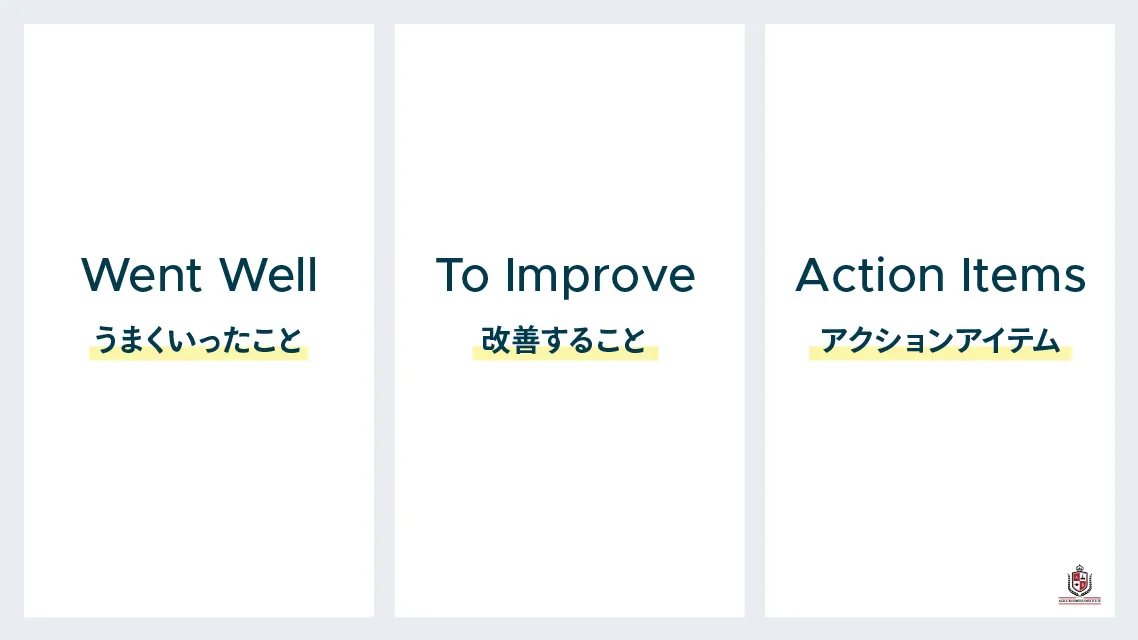

What Went Wel is a retrospective method that uses a framework to think from three perspectives: “Went Well,” “To Improve,” and “Action Items.”
Each team member writes “Went Well” and “To Improve” on the chart as they review the sprint.
This is very intentional. It’s easier to say, “What worked and what didn’t?”
But when you say, “What worked and what do you want to improve?” the focus shifts from negativity and frustration to positive, constructive feedback.
Share within your team and write down your ‘Action Items’ for the next sprint for ‘Went Well’ and ‘To Improve’. Also put these items in order of priority.
Start Stop Continue
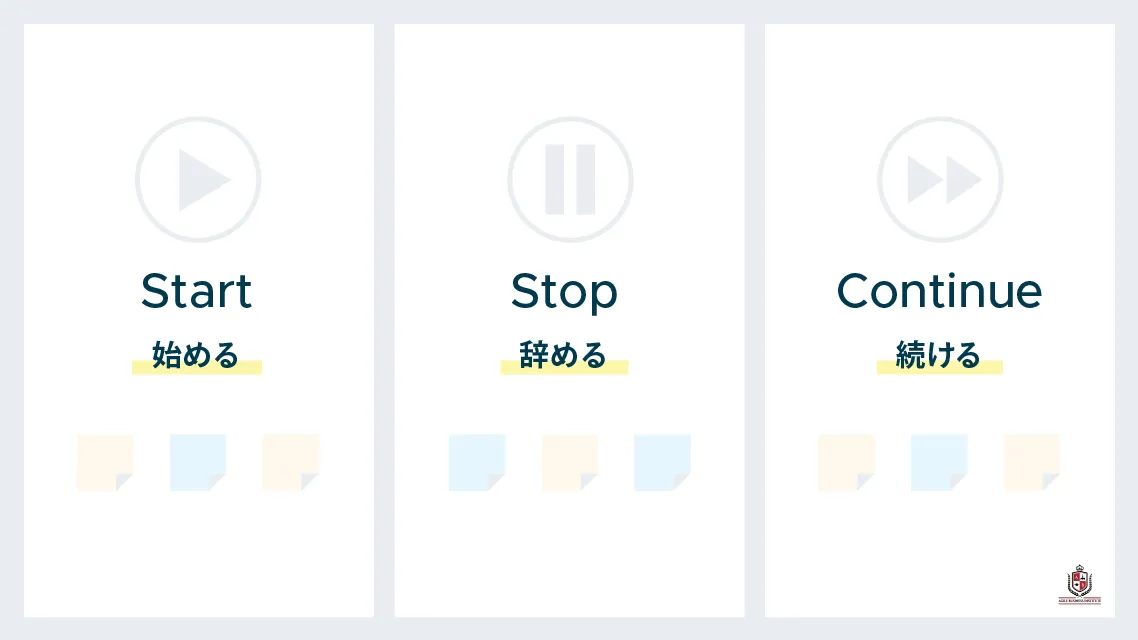

Start Stop Continue is a retrospective method that uses a framework to think from the three perspectives of “Start”, “Stop” and “Continue”.
Each team member writes “Start”, “Stop” and “Continue” and displays them on the table while looking back on the sprint.
Share within the team. If you have similar items, group them together.
The team votes to decide which ideas to proceed with and which ideas to discard for now in order to decide on improvements for the next sprint.
Looking at the simplified board, the team discusses each category. Start Stop Continue is to eliminate the negative elements of the process and strengthen the positive elements.
Mad sad Glad


Mad Sad Glad is a retrospective method that uses a framework to think from the three perspectives of “Mad”, “Sad” and “Glad”.
Each team member writes “Mad”, “Sad”, and “Glad” on a chart as they review their sprints. And share it with your team.
In order to narrow down the items for discussion, a vote will be held to select a few items. The team then discusses and thinks about improvement items for the next sprint.
speed boat
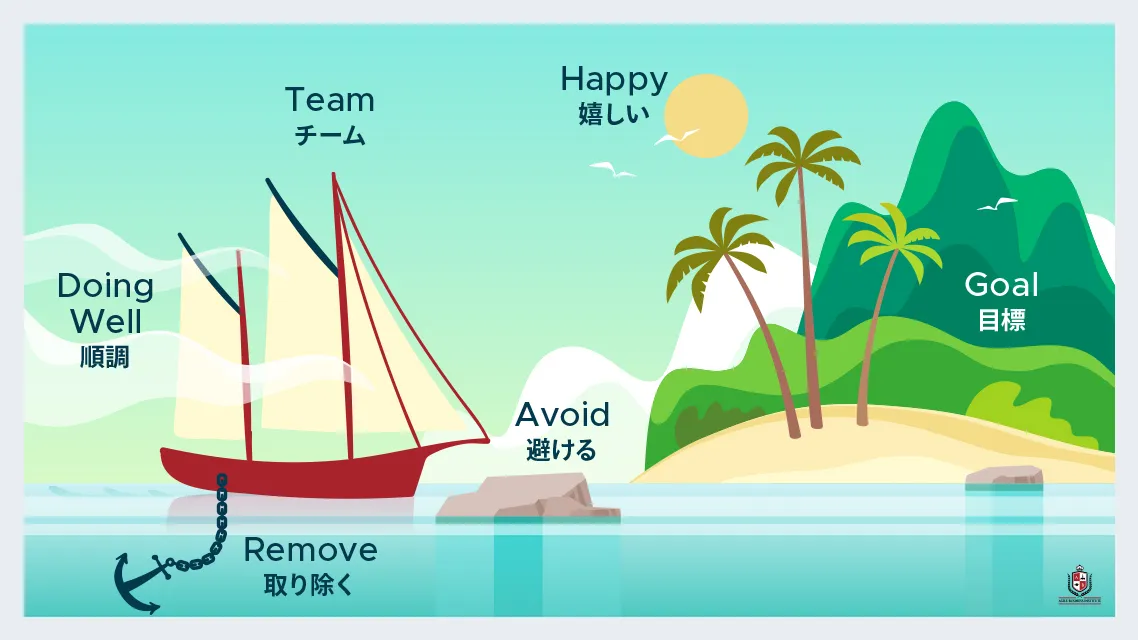

Speedboat is a fun and interactive framework for teams to reflect on their sprints. This retrospective approach helps you visualize your ship (the team) reaching its destination (the project goal) as the yacht heads for shore.
Yacht: The team itself
Sun: What went well, what makes you happy
Island or coast: The ultimate goal or vision of the team
Splash (wind or sail): What helps the team stay on
track Anchor: The team or project What is blocking or slowing progress
Rocks: project risks or potential risks
While looking back on the sprint, each team member writes out the items that come to mind and displays them in the appropriate places on the illustration. and share it within the team.
The team votes on which items to improve in the next sprint. Discuss how to improve them in the next sprint.
starfish
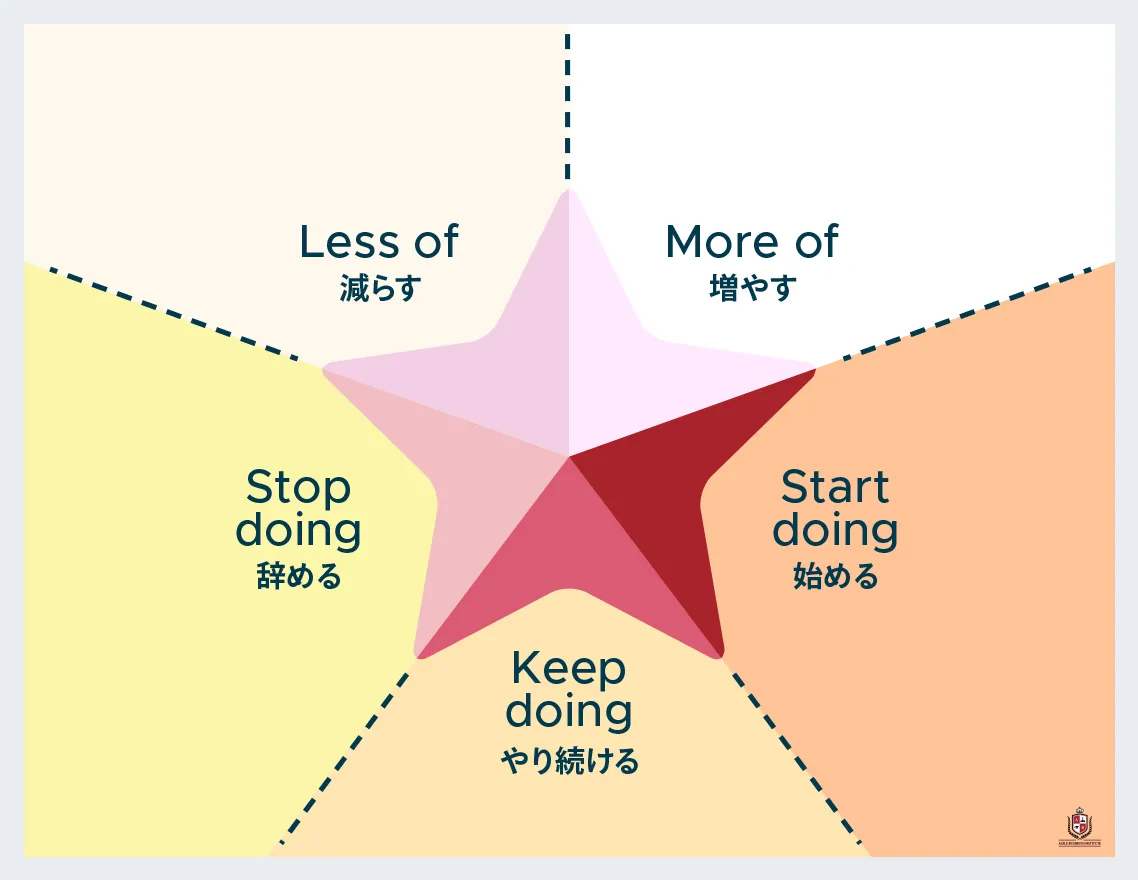

Starfish is a retrospective method that uses a five-point thinking framework using a starfish diagram.
- Keep doing: something your team is doing well and appreciates
- Less of: Things that are currently being done but want to be reduced
- More of: Things that are currently being done but would like to do more
- Stop doing: something worth quitting
- Start doing: new ideas or new beginnings
Each team member reviews the sprint, writes down the items that come to mind, and displays them on the corresponding part of the starfish.
Discuss each category as a team. After talking about the negative categories, what do you start with and end on a positive note?
three little pigs
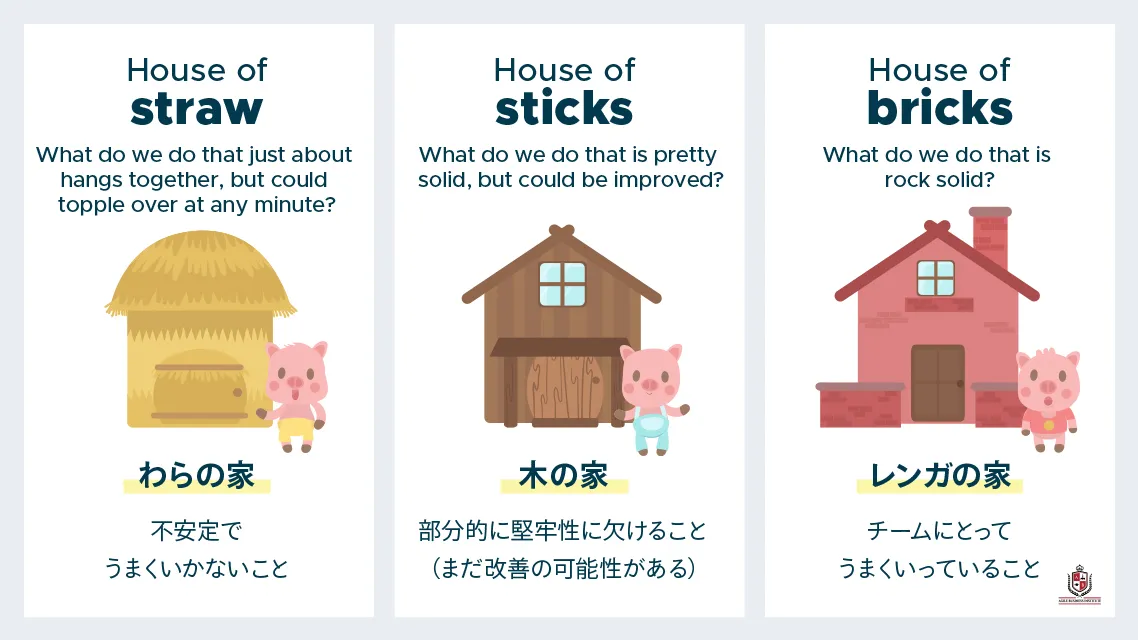

It’s a retrospective method that uses a fun framework to retrospectively look at the three types of “houses” of the three little pigs in nursery rhymes.
Straw House: Instability and Things That Go Wrong
Tree House: Partially lacking robustness (still could be improved)
Brick House: What’s Working for the Team
Each team member reviews the sprint and writes down the items that come to mind and displays them in the corresponding place in the house of the three little pigs.
Share within your team. The team votes on which items to improve in the next sprint. Discuss how to improve them in the next sprint.
speed car
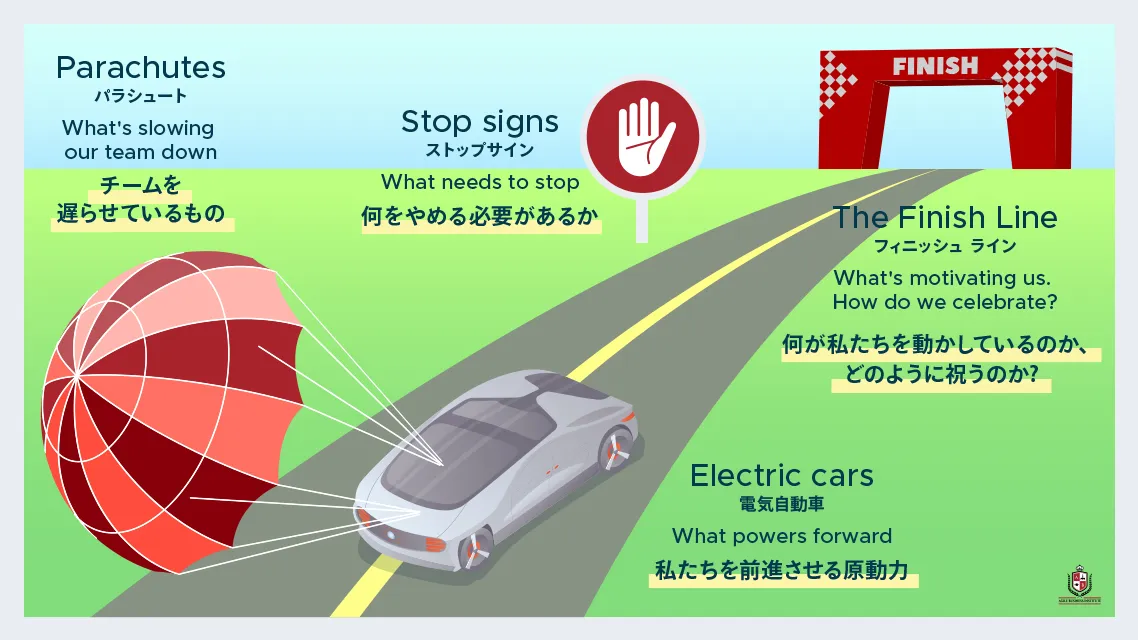

Comparing the team to a racing car, Speed Car provides a visual representation of what is holding back and what is driving the team forward. Also think about how to celebrate when you cross the finish line.
Parachutes: what’s holding the team back
Electric cars: the driving force that keeps us going
Stop signs: what we need to stop
Finish line: what drives us and how to celebrate?
While looking back on the sprint, each team member writes out the items that come to mind and displays them in the appropriate places on the illustration. and share it within the team.
In order to narrow down the items for discussion, a vote will be held to select a few items. The team then discusses and thinks about improvement items for the next sprint.
Develop a celebration plan for how the team will celebrate achievements, such as improvements at the end.
Retrospective FAQ | Tell me Joe!


- It tends to be retrospective and mere formality. What should I do?
-
SM is also a facilitator. Again, explain the purpose of the retrospective to the team. Also, there are many methods, so please try to change the method from time to time and make it a fun retrospective that feels like a game!
- Who Should Attend a Retrospective?
-
Ideally, all team members should participate. If there are members who cannot participate, it is also possible to hold the meeting centered on the developers who are most involved in “process”, “technology” and “team”. But we also need activities that promote psychological safety so that everyone can participate.
- Please advise retrospective caveats!
-
A Harvard study proves that increasing team happiness leads to improved speed. I have experienced many times that speeding up when team members are happy.
Psychological safety is very important in making Agile work. Once in a while, think about the happiness and refreshment of your team members.
Retrospective recommended tools
We’ve shown you a few techniques, and there are great tools to do them online.
Here you can easily use 35 techniques.
Recommended tools for retrospectives
Retrospective Summary
I introduced several methods, but the only difference was the way they were presented, but the purpose of looking back on “what went well” and “what didn’t go well” was almost the same.
Remember, retrospectives are always positive conversations.
We tend to focus on what went wrong, but remember that all team members celebrate successes and share happiness. Sometimes, how can “improvement” extend happiness? It’s okay from that point of view.
Please do a positive retrospective while incorporating new techniques.
コメント